This took a quite a bit of thought and much rearranging of the list from number 5 onwards, as it is difficult to pinpoint influences retrospectively. As a guitar enthusiast primarily and not a musician, I think it is an important exercise to convey where my ideas for guitar projects originate musically. Not only the look and style of a guitar, but more importantly the sound and tone I am trying to create in my instruments.
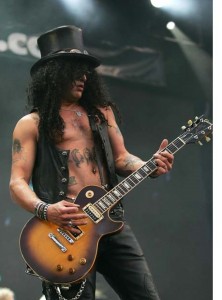 1 : Slash
1 : Slash
Saul ‘Slash’ Hudson is quite simply the reason I persevered with the guitar as an instrument.
There was a staggered delay on the rock bands my brother and I enjoyed when we were young. Lee first started listening to Bon Jovi albums while I was still listening to Rainbow and Iron Maiden, and when he moved on to Guns N’ Roses, I started enjoying Bon Jovi, and so on (this trend actually carries on to this day, most recently with the guitarist Joe Stump). It took me a long time to get into Guns N’ Roses, simply because Lee had played Sweet Child o’ Mine and Paradise City so obsessively that I had begun to develop a tick at the very sound of them.
It was at the release of the Use Your Illusion albums that I began to enjoy the more melodic and structured songs that appeared on these two albums, and eventually I would start listening to the Appetite album religiously.
Slash has developed what seems to be a signature ‘tone’ over time that he is most renowned for, and this is cited on many reviews of albums and even kit such as signature guitars, amps and effects. Notably a creamy warm sustain achieved by the neck pickup selection through a Marshall stack, and even sometimes through a Dunlop Cry Baby with the treble rolled back. Incidentally this is not the sound I associate with Slash’s best work. I prefer the harsher bridge tone heard on the Appetite album, especially on the track Night Train. This aggressive bite almost leans over into the single coil territory until the power chords and double stops make it more obvious that’s it’s a very hot-wound humbucker.
The low slung guitar, top hat and leather jacket is the iconic image that made me want to play lead guitar as a teenager and began my obsession with the carved top solid body Les Paul guitar.
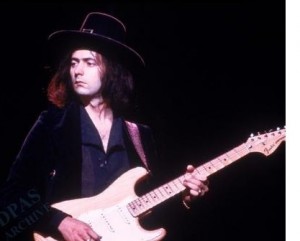 2 : Ritchie Blackmore
2 : Ritchie Blackmore
I never got the whole Deep Purple thing, I just don’t find the progressive rock sound very appealing, but as my Dad didn’t have any Deep Purple albums, I never really listened to them growing up either. What I can remember from as early as memory allows is listening to my Dad’s ‘Best of Rainbow’ double LP. Blackmore’s guitar style was so distinctive and profound even at four years old, it seemed like a totally different instrument than a boring old guitar. It was always the Dio tracks on the compilation album that were my favourites because of the fantasy oriented lyrics and his awesome voice. This coupled with the neo-classical nature of the guitar leads made Rainbow one of my all-time favourite bands to this day. Stargazer remains one of my favourite songs equally for the guitar passages and the lyrics. Later as I began to play guitar, I tried a few times to play Blackmore pieces after finding Tab for different tracks, but I always found it very difficult to play and almost counter intuitive compared to pieces I had leaned after picking up the instrument (Metallica, Guns N’ Roses etc). It’s a very singular style and cannot be compared to other artists in my opinion.
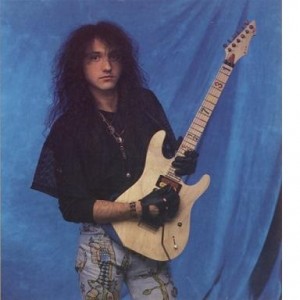 3 : Jason Becker
3 : Jason Becker
The Cacophony album with Marty Friedman is a work of art in terms of shred guitar. Pre-YouTube days, it was difficult to distinguish the two guitarists on the CD, but I realised over time listening to Friedman’s work with Megadeth that it was Becker’s tracks that were my favourites. A very short musical career, sadly due to ALS disease meant there is a very limited catalogue of Becker’s material to listen to, but the effortless intricate shredding technique still sounds unique and recognisable in a genre flooded with virtuosos.
I’ve never been a fan of whammy bars, apart from when I had never played one, which made it the only thing I wanted in a guitar; but Becker’s use of tremolo bar adds another facet to the instrument that is very daunting for a learning guitarist. It’s the ability to play soulful passages within runs of hyper-speed arpeggios makes his work very special for me. ‘Throat Hole’ from the Raspberry Jams album is one of the most soulful pieces of solo guitar I have ever heard.
I’m glad to hear Seymour Duncan have recently released a signature pickup authorised by Jason which sounds awesome; I’ll definitely be using these on a build at some point in the future.
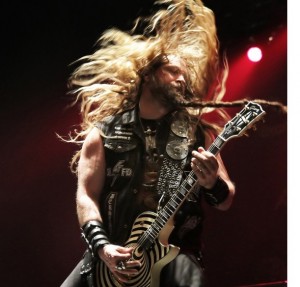 4 : Zakk Wylde
4 : Zakk Wylde
My brother and I would often talk about our favourite guitarists’ instruments and surmise that it must be the deep cut-outs allowing high-fret access and thinner neck profiles of the Ibanez/Charvel type guitars that allowed guitarists to play so fast, and the reason why there weren’t any true shredders using Les Pauls.
Zakk Wylde changed all of that.
The first time I heard of Zakk Wylde was when Lee showed me the liner note of Ozzy Osbourne’s ‘No More Tears’ album, which showed Zakk stood brooding with a bowler hat on, which I remember thinking at the time meant that he would be the next Slash. I didn’t see him actually play the guitar for a few years until an episode of Raw Power (which turned into Noisy Muthers), a late night heavy metal TV program, where he was playing with his new solo project Pride and Glory. Probably the most animated full-on shred guitarist I’ve ever seen, I still don’t know how he plays so fast with his Les Paul slung so low. His technique of favouring the picking of every note opposed to legato has been a big influence on my own playing, and I find I judge other guitarists on this ability also.
I loved the Bullseye Les Paul that identifies him instantly along with the sheer speed of pentatonic licks and wide vibrato, not to mention the frequent pinched harmonics throughout. I remember sat with my crappy Encore Strat copy guitar and a copy of Total Guitar magazine one Saturday in my mid-teens, reading a description of how to perform a pinched harmonic.
There aren’t many mass produced guitars I would like to own any more, but a Zakk Wylde signature Les Paul is still on my wish list. I’m not personally a fan of active electronics like the EMG’s Zakk uses, but I am a massive fan of the raw maple neck, cream/bullseye finish and full block inlays used on his signature model.
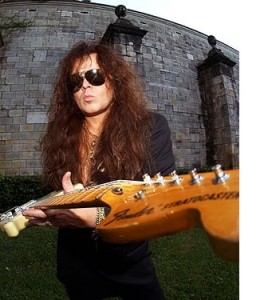 5 : Yngwie J. Malmsteen
5 : Yngwie J. Malmsteen
It took me a long time to get into Yngwie, but then there is no going back. Another cast-off from my brother, we found the ‘Live in Leningrad’ album in the Rotherham library which featured a rental service of books, VHS and CDs. This is how we acquired the majority of heavy metal albums at the time, but Yngwie was totally different to anything else we had heard. I had not heard really anything that fast before and it was difficult to appreciate what was going on with the heavy classical influence woven through it all. Later learning to love all of Yngwie’s work, it was his guitar itself that fascinated me for years. Yngwie uses a scalloped fretboard on the majority of his Stratocasters, an idea based on the design of a 16th century Lute. The signature Malmsteen Stratocasters we way out of the realms of financial possibilities, so I decided to build Lee one (The Duck) on the cheap so that I could also get to play a scalloped neck too. This build was the first real guitar project for me and led on to me wanting to create my own designs.
The scalloped neck does feels nice and allows a lot more grip when bending strings, which lent itself surprisingly well to the Blues. I had a scalloped neck on my own No.2 guitar for a few years, but I’ve recently changed for a traditional flat board and jumbo frets, as it’s too easy to bend sharp when fretting heavily.
Sadly I doubt I’ll ever be able to play 90% of Yngwie’s music, I still enjoy listening to his earlier work frequently.
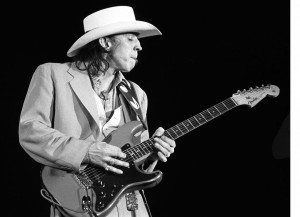 6 : Stevie Ray Vaughan
6 : Stevie Ray Vaughan
I listened to a lot of SRV in my first year of University, and is basically how I got to love Blues music in general. I first heard The Sky is Cryin’ on Paul Jones’ Radio 2 Blues program one night as I was playing on the X-box. The first thing that struck me was the tone of the guitar was so thick, it was hard to believe he was playing a Strat. I liked how his work sometimes almost bridged the divide between Rock/Metal and traditional Blues. I treated myself to a SRV back catalogue Tablature book and slowly began to learn different riffs, licks and solos from his albums. ‘Mary had a little Lamb’ from the ‘Texas Flood’ album was the first song I learned to play all the way through.
Reading about SRV’s setup influenced my own preferences of heavier gauged strings, jumbo frets and an action on the higher side.
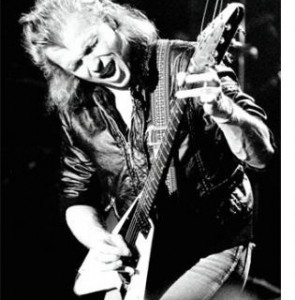 7 : Michael Schenker
7 : Michael Schenker
Another guitarist who is instantly recognisable; black and white flying V, platinum blonde hair and half-crouching stance, Schenker has written some of the best guitar riffs in classic rock history.
I love the ‘bite’ to Michael’s tone that gives his soloing a harsh edge. I have learned fairly recently that this is achieved by passing his guitar signal through a Cry Baby Wah that is fixed majorly into the treble section. His black and white Flying V guitar is such an iconic instrument and brilliant design, I intend to use this as an inspiration for my own V guitar build in the future.
It can be quite difficult to play Michael’s music the way he plays it himself. During an ascending scale, where most guitarists would instinctively skip over to the higher strings, Schenker often travels up the neck and remains on the same string. This can be tricky to grasp at first, but there are some definite tonal advantages of staying on the bass ‘wound’ strings for the higher frets in solos.
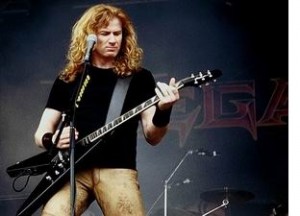 8 : Dave Mustaine
8 : Dave Mustaine
I think Dave Mustaine is highly underrated as a guitarist in his own right. He has written some searing solos throughout Megadeth’s career along with many of the best Heavy Metal riffs ever heard. Giving his own stamp on the Flying V type guitar, he prefers very pointy pure Metal instruments and incorporates many complex rhythms that are similar to James Hetfield in Metallica, and yet recognisably individual and unique.
Hanger 18 from the ‘Rust in Peace’ album remains one of the best Thrash Metal tracks of all time, and features something like eleven separate solos shared between Mustaine and Marty Friedman.
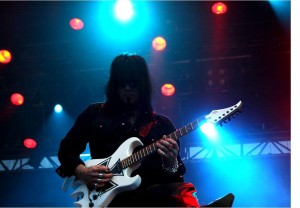 9 : Joe Stump
9 : Joe Stump
Initially I ignorantly wrote Joe Stump off as ‘just another Yngwie copy’ when Lee first brought him to my attention around ten years ago. There is no doubt that his style is very heavily influenced by Malmsteen, but he surprisingly has a much more noticable Blackmore influence to his playing than Yngwie ever has.
I personally believe he is currently creating the greatest heavy rock/metal solo guitar work from all I have heard, and has a greater depth of musical scope when compared to Malmsteen’s recent work.
Joe uses scalloped fretboards and a variety of Yngwie signature models, his own ESP signature models and custom MC Guitars models.
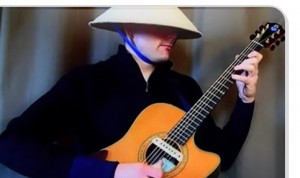 10 : Ewan Dobson
10 : Ewan Dobson
My girlfriend Chloe and I went to see a guitarist called Ewan Dobson just before Christmas 2013, and was simply blown away by his performance. Using a fingerpicking style and exclusively acoustic guitars onstage, Ewan progressed through a series of instrumentals incorporating advanced and ridiculously intricate techniques and rhythms. He is literally the greatest guitarist I have ever had the privilege to watch perform in person and I look forward to all his future releases.
Ewan references computer game themes in many of his pieces, and many of the themes of his playing resemble old SID chip compositions that used to appear in Commodore 64 games in the 80’s. Partly influenced by his performance in December, I plan to theme a guitar project in the future on my beloved Commodore 64, including sprite inlays along the fretboard and active electronics with arcade buttons etc. on the guitar body.
